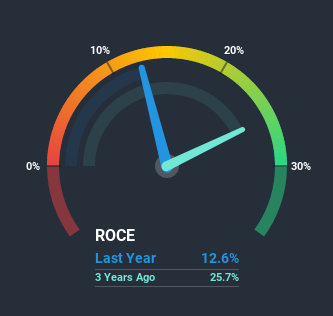- India
- /
- Consumer Durables
- /
- NSEI:BAJAJELEC
Here's What's Concerning About Bajaj Electricals' (NSE:BAJAJELEC) Returns On Capital

What trends should we look for it we want to identify stocks that can multiply in value over the long term? Ideally, a business will show two trends; firstly a growing return on capital employed (ROCE) and secondly, an increasing amount of capital employed. This shows us that it's a compounding machine, able to continually reinvest its earnings back into the business and generate higher returns. In light of that, when we looked at Bajaj Electricals (NSE:BAJAJELEC) and its ROCE trend, we weren't exactly thrilled.
Return On Capital Employed (ROCE): What is it?
For those who don't know, ROCE is a measure of a company's yearly pre-tax profit (its return), relative to the capital employed in the business. The formula for this calculation on Bajaj Electricals is:
Return on Capital Employed = Earnings Before Interest and Tax (EBIT) ÷ (Total Assets - Current Liabilities)
0.13 = ₹2.1b ÷ (₹43b - ₹26b) (Based on the trailing twelve months to December 2020).
Thus, Bajaj Electricals has an ROCE of 13%. In absolute terms, that's a pretty normal return, and it's somewhat close to the Consumer Durables industry average of 11%.
Check out our latest analysis for Bajaj Electricals

In the above chart we have measured Bajaj Electricals' prior ROCE against its prior performance, but the future is arguably more important. If you'd like, you can check out the forecasts from the analysts covering Bajaj Electricals here for free.
The Trend Of ROCE
The trend of ROCE doesn't look fantastic because it's fallen from 27% five years ago, while the business's capital employed increased by 83%. Usually this isn't ideal, but given Bajaj Electricals conducted a capital raising before their most recent earnings announcement, that would've likely contributed, at least partially, to the increased capital employed figure. Bajaj Electricals probably hasn't received a full year of earnings yet from the new funds it raised, so these figures should be taken with a grain of salt. Additionally, we found that Bajaj Electricals' most recent EBIT figure is around the same as the prior year, so we'd attribute the drop in ROCE mostly to the capital raise.
On a separate but related note, it's important to know that Bajaj Electricals has a current liabilities to total assets ratio of 62%, which we'd consider pretty high. This effectively means that suppliers (or short-term creditors) are funding a large portion of the business, so just be aware that this can introduce some elements of risk. Ideally we'd like to see this reduce as that would mean fewer obligations bearing risks.
What We Can Learn From Bajaj Electricals' ROCE
In summary, we're somewhat concerned by Bajaj Electricals' diminishing returns on increasing amounts of capital. Yet despite these poor fundamentals, the stock has gained a huge 414% over the last five years, so investors appear very optimistic. In any case, the current underlying trends don't bode well for long term performance so unless they reverse, we'd start looking elsewhere.
One final note, you should learn about the 4 warning signs we've spotted with Bajaj Electricals (including 1 which can't be ignored) .
For those who like to invest in solid companies, check out this free list of companies with solid balance sheets and high returns on equity.
If you’re looking to trade Bajaj Electricals, open an account with the lowest-cost* platform trusted by professionals, Interactive Brokers. Their clients from over 200 countries and territories trade stocks, options, futures, forex, bonds and funds worldwide from a single integrated account. Promoted
Valuation is complex, but we're here to simplify it.
Discover if Bajaj Electricals might be undervalued or overvalued with our detailed analysis, featuring fair value estimates, potential risks, dividends, insider trades, and its financial condition.
Access Free AnalysisThis article by Simply Wall St is general in nature. It does not constitute a recommendation to buy or sell any stock, and does not take account of your objectives, or your financial situation. We aim to bring you long-term focused analysis driven by fundamental data. Note that our analysis may not factor in the latest price-sensitive company announcements or qualitative material. Simply Wall St has no position in any stocks mentioned.
*Interactive Brokers Rated Lowest Cost Broker by StockBrokers.com Annual Online Review 2020
Have feedback on this article? Concerned about the content? Get in touch with us directly. Alternatively, email editorial-team (at) simplywallst.com.
About NSEI:BAJAJELEC
Bajaj Electricals
Engages in the consumer durables; and engineering, procurement, and construction businesses in India.
Excellent balance sheet with reasonable growth potential and pays a dividend.


